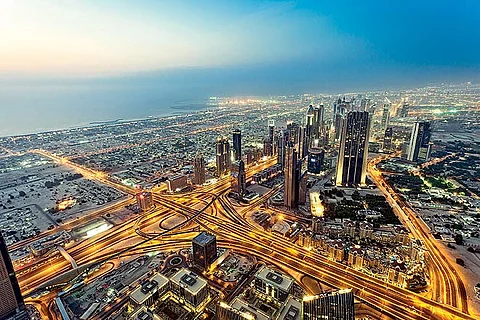
- Destinations
- Experiences
- Stay
- What's new
- Celebrating People
- Responsible Tourism
- CampaignsCampaigns
- SubscribeSubscribe
- Buy Now

In the 2010 Hollywood film Sex And The City 2, an Abu Dhabi official, flaunting the allure of his sheikhdom as compared to its Emirati brothers, puts down neighbouring Dubai as a relic of the past. &ldquoIt&rsquos so over,&rdquo he says, a cinematic jibe that rankles with the good folks at Dubai, who are determined to disprove popular perceptions of its decline. And they&rsquore going about disproving it in the only way they&rsquove known&mdashbuilding bigger, taller and quintessentially, um, &lsquoDubai-er&rsquo architectural wonders and hosting mega-events.
The Dubai events calendar is pretty full in the short term with a succession of seasonal and annual carnivals in June, the sheikhdom will host the Dubai Desert Road Run, a Middle East Sports Events summit, and a Disney on Ice event and in July, in the middle of the Ramadan month, Dubai lines up Summer Surprises, and a splendid Eid festival to end the month of fasting. But the mega-event in the longer term, which all of Dubai is working towards in mission mode&mdashevidence of which you can see in the mammoth public works building binge going on&mdashis the World Expo 2020. Some 25 million people are expected to visit the Expo during the six months that it will run, and in preparation for that, the world&rsquos biggest (nothing else will suffice) airport, capable of handling 160 million passengers a year, is getting set to take off.
But it&rsquos not just with brick and mortar that Dubai is redefining itself. Home to some 200 nationalities, and arguably the most liberal minded emirate, the city-state is also looking to loosen up its staid, uptight persona. I was witness to fledgling efforts in that direction at a recent luncheon hosted by Dubai&rsquos Department of Tourism and Commerce Marketing (DTCM). As we gorged on kabsa and machboos (chicken rice dishes), and followed it up with melt-in-your-mouth mahalabiya (an Egyptian milk custard) and a scrumptious esh asarya (a cheesecake, more commonly known as the &lsquobread of the harem&rsquo), we were enlivened by a stand-up comedy show by Nasif Kayed of the Sheikh Mohammed Centre for Cultural Understanding.
Within the permissible limits for performing arts, Kayed kept up a moderately droll routine centred around &ldquocultural stereotyping&rdquo of the Arab world. While appearing to make fun of folks in the Arab world, it also served to shatter some of the prevailing myths about the region. It is part of an ongoing effort to enable greater cultural understanding for those who travel or live in the city-state, but for me it marked a striking milestone. If it is true that civilizations can be said to have evolved only when they begin to laugh at themselves, this erstwhile fishing and trading village in the desert is taking its first tentative steps on that evolutionary road.
Some elements of daily life in Dubai are rather more funny than the best stand-up comedy routines. Indicatively, the Dubai Metro website flags a fine of AED300 for&mdashI kid you not&mdashsleeping in the Metro. Metro authorities, however, claim that it will only be considered a no-fine violation.
Even so, I remained pointedly awake as I zipped up and down the fully automated, elevated Metro lines, gazing in wonderment at the megapolis of steel, metal and glass that came up in just the past 40 years. Ultra-modern Dubai is not without appeal, and in particular the view from the observation deck of the Burj Khalifa&mdashthe world&rsquos tallest (what else) building&mdashis dizzyingly dramatic. And the hotel that I stayed in&mdashAtlantis, the Palm, on the Palm Jumeirah, and the setting for the Shah Rukh Khan starrer Happy New Year&mdashis a luxurious Grecian themed world in itself, with a wall-to-ceiling aquarium and a PADI accredited 5-star dive centre.
But it is when you venture into the Old Dubai quarters, close to the Gold Souk and the Spice Souk, that you feel the rhythm of times gone by. On the shimmering Deira Creek, traditional dhows still ply, their elementary rusticity in striking contrast to the glitzy buildings on either bank. I hopped on to a ferry, and sat up-front, taking in the slow lap-lap of the waters and the quiet flow of life. I was headed for Bastakia, Dubai&rsquos first settled area on the south western bank of the creek. Today, it&rsquos a pedestrianised area that bustles with commerce and culture. Indian and Pakistani traders ply their wares roadside cafés serve up local delights and, elsewhere, a calligraphy institute was showcasing its cursives.
I rounded a Bastakia bend, and was greeted by the blast of a rocking disco tune from the courtyard of a simple grey house. Curious, I sauntered in&mdashthe place had a welcoming feel to it, so I didn&rsquot feel like I was intruding&mdashand chanced upon an art session for adults with special needs. They were drawing hearts on a canvas, and the whole place reverberated with joyous enthusiasm. Gulshan, the art teacher at Mawaheb From Beautiful People (www.mawaheb-dubai.com), sashayed up to me and asked if I wanted to join in. Of course I did
And there, in the middle of Old Dubai, this traveller from faraway shores found himself enveloped by a love that was perhaps taller than the Burj Khalifa and deeper than the waters of the Persian Gulf. This Emirate of excesses can throw just such a curve ball of love in the most unexpected places.
